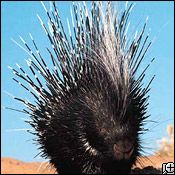There are three species in the genus Hystrix, including H. indica, which derives its common name, crested porcupine, from its ability to form a crest by erecting the quills on the head, back, and nape.
It also possesses specialized rattle quills on its tail that it can agitate, making a startling whizzing sound that sometimes deters predators.
Advertisement
When that doesn't work, the porcupine turns around and rams the predator with its quills.
It shares its burrow with a family group composed of up to fifteen other individuals.
They forage primarily on fallen fruits, roots, tubers, and seasonal bulbs. They also gnaw on bones, sharpening their teeth and perhaps acquiring supplementary calcium for their diet.
Advertisement
